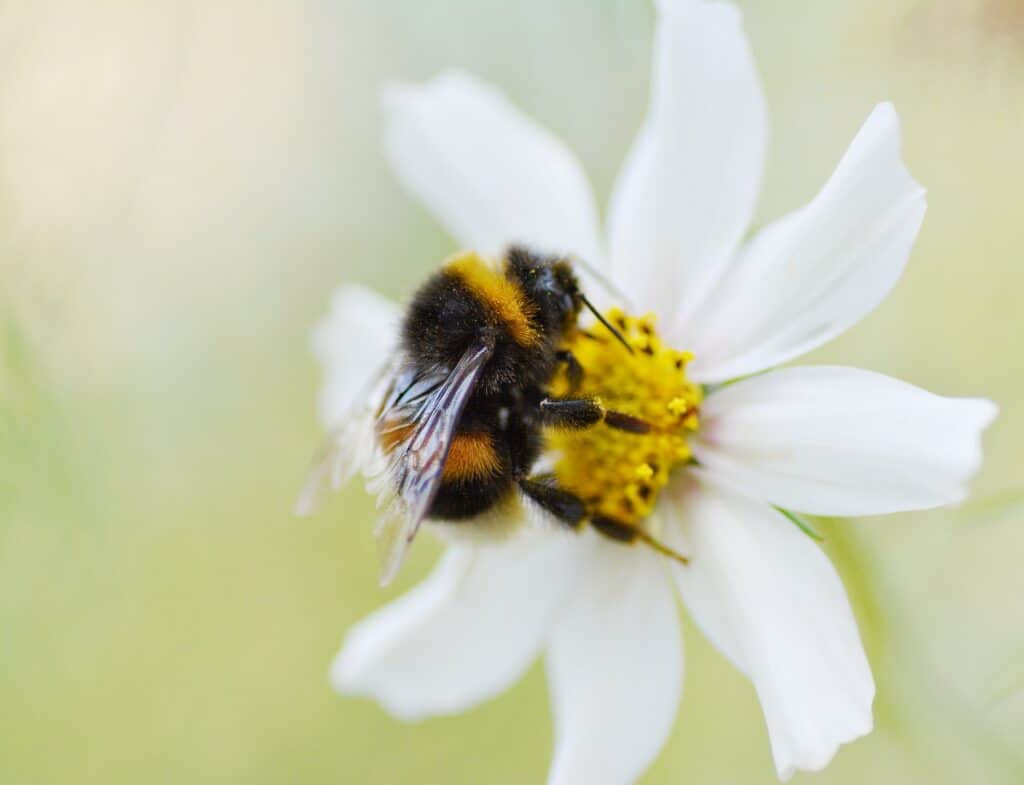In the day of the perfectly manicured lawn, there can be a lot of pressure for your yard and home to look a certain way and be perfectly pest free. This ideal does not come without risk though. Many yard treatments involve toxins that can harm your family, pets and the ecosystem. In this post, we’ll examine why and how you should give natural pest management a try.

Problems with Conventional Pest Treatments
Honestly, I could link to dozens of scary studies about the dangers of pesticides. We know without a doubt that pesticides are dangerous to living creatures, including humans. The answer that isn’t so clear is, “At what point do they become dangerous?”.
For clarification purposes, pesticide is a broad category that includes insecticides, herbicides, fungicides and rodenticides. In this post, we’ll mainly be focusing on insecticides.
It wasn’t until I had children that I started to really research the dangers of pesticides. One of the first studies that stopped me in my tracks was a Harvard study that suggested indoor pesticides increased cancer and brain tumor rates in children. I had already transitioned to eco-friendly tactics at home, but this study encouraged me to look further and immediately ask questions at my kids’ school and preschool.
What is Integrated Pest Management (IPM)?
Thankfully, both settings were using Integrated Pest Management, IPM. IPM is essentially a minimally invasive, conservative way to use pesticides. I live in Tennessee, so I got lucky as this is not the norm in my area.
One of my old workplaces used to (and may still) actually allow someone to come in and spray conventional pesticides all around the office buildings in the middle of the day. I always declined for my office when I was there and brought it up for discussion multiple times over the years but sadly nothing changed.
It’s not just children who are at risk from pesticides—adults are too. There are numerous studies suggesting an increased cancer risk coincides with increased pesticide exposure in occupational and nonoccupational settings.
Meaning you don’t have to work with pesticides or grow crops to be at risk. You can simply live in an area with high pesticide use and have a higher risk of certain cancers. Here is just one study to consider: Environmental exposure to pesticides and cancer risk in multiple human organ systems.
We don’t always know when we are being exposed to pesticides. They are on our food—check out the EWG’s 2022 Dirty Dozen to avoid the most heavily contaminated foods. Pesticides also seep into the ground and can contaminate drinking water.
Pesticides are often found in well water and public drinking water system samples. This is one of many reasons you want to filter your drinking water with a multi-step water filter that removes pesticides.
Dangers to Birds and Bees
Beyond pesticides posing a danger to humans, we should also consider the risks to our pets, birds and bees. Pesticides in our environment are not only harmful to the pesky spiders and roaches that we want to keep out of our home but also to the animals we love and need.
This 2019 headline from Belgium caught my attention a few years ago, so I went looking for it: Combinations of 36 different pesticides found in thousands of dead birds’ nests. Several areas in Belgium experienced alarming rates of baby bird deaths after pesticides were increased to combat a moth problem.
Local conservationists investigated and found 36 unique pesticides present in the thousands of bird nests including DDT, which has been banned since 1974. This speaks volumes to just how long certain pesticide residues can linger.
You may be aware of the huge decline in the American bumble bee (90% in the last 2 decades). New York, for example, has lost 99% of its bumble bee population. Data shows the states that experienced the greatest decline in bees were the same states with the largest increase in their use of a class of pesticides known as neonicotinoids (neonics).

Neonics weaken the bees’ immune systems, impair their ability to communicate and diminish their ability to find their way back to their homes. You can read more about neonics in this article by the Center for Food Safety.
Getting Started with Natural Pest Management
Now that I’ve given you a lot of bad news (sorry about that), you may be wondering what you can do about it. While we can’t control the world’s pesticide use, we can control ours and help raise awareness.
Let me be transparent and tell you that I am not one of those people who is one with nature and is going to advise you to live side by side with all critters and just deal with it. While I appreciate their purpose (at least most of them), I’m actually not a big fan of small, creepy, crawly things!
Not to mention, there are also health risks associated with certain pests like mosquitos and ticks.
O.k. so what do you do if keeping your family, pets and the environment safe are your top priorities, but you’d rather not have pests in your space? Thankfully, there are a lot of things you can do. I have lived in the city and now in a rural setting, so I am confident these strategies can work for you.
You may need to combine a few to get the desired result but with a little patience you can learn how to manage pests in a minimally invasive, safe way.
1.) Landscaping Strategies to Reduce Pests
Pests like weeds, overgrown areas and standing water, so you want to keep a tidy lawn. Mow, weed and trim your yard regularly, particularly right around the house. Get rid of any structures you aren’t using like old playhouses, swing sets or planters that may hold rainwater.
The neater the yard, the fewer places for pests to hide or take up shop. Frequently look for nests on your house and carefully remove them. If you happen to find a beehive, there are often local beekeepers who will remove and relocate them.
2.) Plants that Repel Pests
There are plants that can safely and naturally help you manage pests. It makes perfect sense as these are the same plants they use make all of the natural pest products. I have read this tip many times, but not pursued it fully.
We just happen to have a few of these herbs around the yard thanks to the previous owners. I am no gardener, but I hope to add a couple more of these powerful plants to my yard soon.

This post contains affiliate links. At no additional cost to you, I may earn a small commission on approved purchases. Your support makes this blog possible!
According to the Farmer’s Almanac, some of the top pest repelling plants are lavender, thyme, basil, mint and lemongrass. Lavender is said to repel mosquitoes, fleas, flies and moths. Thyme and mint are known for repelling mosquitos.
Lemongrass contains citronella, which is a well-known substitute for the controversial synthetic repellant, DEET.
3.) Regular Inspections
If you are doing DIY pest management, you definitely want to incorporate expert inspections, specifically an annual termite inspection. During out most recent inspection I learned that termite protection has become much safer than it used to be.
Years ago, they would treat under your home with surface and injectable sprays but now most companies bury bait traps around the home. I am told it would be extremely difficult for a pet or child to access, but, of course, you will want to monitor them frequently or have a pest company manage them.
Informed pest specialists may also spot issues that encourage pests (e.g. standing water, nests, cracks in your foundation, etc.). Try searching for a company that uses IPM or eco-friendly practices. These types of companies are on the rise. Be sure to ask lots of questions to avoid green-washing practices—these are things that marketed as eco-friendly but are actually not.
4.) Make Your Home Less Appealing/Don’t Feed the Pests
Another important step is to not invite pests into your home. O.k. so no one really invites pests in, but you don’t want to make your home more appealing than it already is by simply providing shelter, food and water. Keep your home tidy!
Wipe down the counters and table with a drop of dish soap or splash of vinegar after food is prepared or eaten. Don’t let crumbs linger for long. While we don’t smell crumbs, pests do, and they can smell them much farther away than we realize. Sweep regularly, since we can’t always when crumbs have fallen on the floor.
If you have a baby or toddler, be mindful of where they eat. My son once dropped something by the sofa, which is near the front door, and within 24-hours we had a trail of ants enjoying a feast. I keep my kids at the table 99% of the time, but with little ones things happen.
I know some kids who are allowed to snack in front of the TV in their cozy chair. If this is the case in your home, you might want to take shake that chair out and vacuum the rug daily during the summer months.
All pests need and want water. Check your sinks, under the house, around your HVAC and anywhere else water could leak. Keep water wiped up after bath time or a spill and fix any leaky faucets as quickly as you can.
On hot summer days, it doesn’t take long for ants to locate water sources. Standing water outside of the house will also attract pests. Make sure the HVAC is draining properly and check any spigots located on or near the house for drips.

5.) Secure Entry Points
Securing entry points is essential for safe pest management. Make sure the weather stripping on your windows, doors and garage doors is intact. Of course, if windows and doors are old, replacing them will help, but if you can’t do that at the moment, simply replacing the weather stripping may help some.
Various types of weather stripping are easy to find on Amazon or any home improvement store. There are many different styles, so be sure to look at what you currently have. Also, be sure to check your window and door screens for tears especially if you open windows and doors often.
6.) Glue Boards to the Rescue
Pest glue boards are game changers plain and simple! If I could only do one thing, it would likely be this. They work with almost any pest except ants (crumbs would be my focus for ants). My pest guy introduced me to these, but now I order them and place them myself.
In the winter, I don’t have to change them often, but in the summer it’s about monthly. I use them mostly in the garage, which is also the main entry point for pests in our home and keep one on our covered porch.
I put them in a couple of spots inside the home too like the bathroom right off the garage. They are fairly small, so you don’t really notice them in any of these places unless you are looking for them.
You won’t believe how many bugs you can catch with glue boards. I frequently find them filled with roaches, spiders and mosquitos. The glue traps I use are just glue and cardboard, so there are no pesticides or other dangers except getting something stuck in one. Most will fold into boxes, and I highly recommend folding them.
You will want to handle these with care! One of mine came unfolded once and my poor cat somehow got it stuck to him. I have also dropped one on the hardwood floor, and it stuck fast (no damage thankfully).
7.) Utilize Natural Remedies
There are quite a few natural remedies you can add to your toolbox for natural and safe pest management. Demetrius Earth (DE) is very popular as are essential oils. DE can be used to create a barrier around your home to keep pests out. It is considered safe but be careful not to inhale it when applying.
DE is not poisonous but kills insects when they ingest it. It will wash away in the rain, so it requires frequent application. Our former pest guy would use a natural essential oil blend around the perimeter of our house.
Unfortunately, essential oil products do not last quite as long as traditional measures, but they do work and sure smell amazing! We used to treat our basement with this also as we just couldn’t keep house centipedes out of there (yuck!).
For ants, my trick has always been a cotton ball with peppermint oil in the area they are frequenting. It can take a couple of weeks to be completely honest, but if you keep removing the ants and placing a fresh peppermint oil cotton ball every few days, they will eventually leave.
If ants are a frequent issue for you, you may be interested in my related post about natural ant deterrents.
For the Yard
First, let me say if you don’t have an issue, there is power in letting it be. Some studies show that treatments can lead to more insects as they can kill off insects that eat the insects you are targeting. We have seen this especially with mosquito populations.
That being said, if issues arise, there are some safer alternatives to traditional yard treatments. I have a bit of personal experience with is EcoSmart all-natural granules that you can spread over the yard with a sifter. You can use an old kitchen colander to apply it.
I have used EcoSmart several times the week before an outdoor gathering like a birthday party or BBQ. It seems to be effective in minimizing mosquitos, and we haven’t spotted any ticks on those occasions. I have used it 3-4 times over the past several years only in our immediate yard.

Vet’s Best and Wondercide both offer a yard spray that you can hook up to the hose. Both brands offer large refill options to save you money on future applications.
I used Vet’s Best several days prior to our 4th of July celebration last summer. We weren’t really having any issues, so I can’t say with confidence that it deterred pests, BUT it was easy to use, smelled lovely and made me feel a little better about having kids literally roll in my yard for hours on the homemade slip-n-slide.
I went with the spray rather than the granules last summer, because we had a new puppy that was still chewing everything, and I didn’t want to risk her eating the granules.
If you have cats, keep in mind that certain essential oils can be especially dangerous for them, so check out the different ingredient options (Wondercide has several formulas) and consider putting pets up at the time of application.
Conclusion
Hopefully, you will try out some of these safe pest management strategies if you haven’t already. I’d love to hear any tips and tricks you may have so feel free to leave a comment below. Check out my related post, if you are interested in non-toxic topical insect repellents.